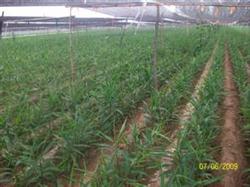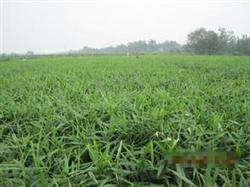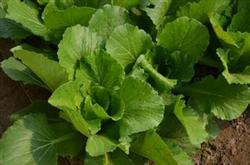Six measures for high yield cultivation of ginger

1. Strictly select land and avoid continuous cropping. Ginger in high temperature and humidity environment, prone to rot disease, commonly known as ginger plague. Ginger blast is a bacterial soil-borne disease, which causes serious continuous cropping and a large number of yield reduction. Because ginger has this destructive disease, ginger should not be continuously cropped, but should be rotated with rice, cruciferous crops, leguminous crops, etc. for 3-4 years. Ginger planting to choose fertile soil, deep soil, organic matter more loam or sandy loam is good. The field is required to be slightly higher in terrain, convenient for irrigation and drainage, and not easy to accumulate water, which is more favorable for preventing the occurrence of ginger plague. Second, disinfection germination, promote early hair. Ginger planting should select fully mature ginger, hypertrophy, with 1-2 strong buds, no disease of old ginger as seed ginger. Ginger seeds need to be disinfected and germinated before sowing. Disinfection methods are many, with 1: 1.5: 120 Bordeaux solution soaking 20 minutes can kill the surface of ginger bacteria. After the ginger is disinfected, it is first dried for 2-3 days. When the moisture on the surface of the ginger blocks disappears, it can be stacked and covered with straw or hemp bags for heat preservation and germination. It is required to maintain humidity and temperature conditions of 20-25℃. When the ginger buds grow to 1 cm, they can be sown. Third, timely sowing, reasonable dense planting. The sowing period of ginger in South China is generally February to March. The size of the seed ginger is 70-100 grams. Ginger density to row spacing 40 cm, plant spacing 20-25 cm is good. Fourth, apply enough base fertilizer, scientific topdressing. Ginger is more resistant to fertilizer and has a long growth period. The principle of applying sufficient base fertilizer and multiple topdressing should be adopted. 1500- 2500kg pig dung and 10- 15kg potassium fertilizer are applied per mu as base fertilizer. Topdressing should be applied thinly, from light to thick. When the seedling height is 15 cm, thin fertilizer is applied once, and when the seedling height is 30 cm, the second fertilizer is applied. After every 20 days or so apply a topdressing. Nitrogen fertilizer was the main fertilizer in seedling stage, and potassium fertilizer should be applied more in rhizome expansion stage. Fifth, shade cooling, promote growth. Ginger is a shade resistant plant, not resistant to high temperature and strong light, scattered light is beneficial to growth. Therefore, shade should be carried out during summer growth to promote growth. Shading methods are many, can be intercropped with wax gourd, Pueraria lobata, taro and other crops, the use of these crops shade. Cool gauze can also be used to build a flat shed for shade. 6. Drought and waterlogging prevention, timely cultivation of soil. Ginger is not resistant to drought, nor to waterlogging, and has strict requirements for moisture. It is advisable to keep the soil moist during the growth period. During the summer high temperature period, should be timely watering cooling, early and late watering is good. Rainwater days should be removed in time to reduce the occurrence of ginger plague. The growth of ginger rhizomes needs a dark and humid environment. As the rhizomes grow upward, the rhizomes are easy to expose to the ground, the epidermis thickens and the quality deteriorates. Therefore, it is necessary to carry out soil cultivation. Generally, the soil is cultivated about three times. The depth of the soil can be determined according to the cultivation purpose. If the tender ginger is harvested, the soil should be deeper, so that the length of the ginger increases and the texture is crisp and tender. If the harvest ginger, then cultivate soil to shallow, so that the roots thick old health.
- Prev

Comprehensive cultivation techniques of high efficiency and high yield of ginger
First, select the sandy loam that has not been planted ginger in the past two years, has a thick soil layer, is close to the water source and is well drained. Second, ginger species selection and treatment selected Leshan Xiba, Gu for filial piety, Xinmin white ginger species. It is suitable to choose ginger with smooth skin, normal bud color, stout and round rhizome, free from diseases and insect pests. After "Rain Water", Xuan Qing.
- Next

High-yield cultivation techniques of Chinese Cabbage in Summer and Autumn
Due to the high temperature in summer and the serious occurrence of diseases and insect pests, it is difficult to cultivate pakchoi, so attention should be paid to strengthening field management. Weeding between seedlings when the seedlings begin to pull the word "ten" for the first time, it is appropriate to go to the seedlings sooner rather than later. When the seedling has 4 true leaves, the second seedling, between weak seedling and diseased seedling, at the same time combined with the market situation.
Related
- Where is it suitable to grow horseradish in China? it is expected to see the middle altitude horseradish in Alishan.
- How to prevent tomato virus disease reasonably? (Control methods included)
- Many people like to plant towel gourd on the balcony. What are the main points of this method and management?
- What crops can chili peppers be mixed with?
- Fertilization techniques and matters needing attention in Tomato
- What are the grafting techniques for peach seedlings in spring?
- Harm and control methods of root swelling disease of Chinese cabbage
- What are the pests of sweet potatoes? How to prevent and cure it?
- Symptoms, causes and Control methods of navel Rot in Tomato
- The cause of "Cucumber rotten bibcock" in Farmers' planting Cucumber and its Control Plan

